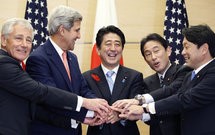 Attended by the defence and foreign ministers of Japan and the US, the regular meetings of the bilateral consultative committee ( 2+2 ) carry considerable significance in that they provide an opportunity for the two countries to constantly assess the strategic environment of the Asia-Pacific region, articulate their policy responses and announce new plans to strengthen their alliance relations.
Attended by the defence and foreign ministers of Japan and the US, the regular meetings of the bilateral consultative committee ( 2+2 ) carry considerable significance in that they provide an opportunity for the two countries to constantly assess the strategic environment of the Asia-Pacific region, articulate their policy responses and announce new plans to strengthen their alliance relations.
The meeting that was held in Tokyo in the first week of October 2013 drew more than the usual interest for certain reasons. First, all four ministers participated in the talks and being somewhat new to their official positions, they had to familiarise themselves with one another in addition to grasping the complexities of the strategic situation of the region. This was also the first 2+2 meeting held after the return to power of Prime Minister Shinzo Abe who has articulated his vision on Japan's future security role in the region. Second, many analysts expressed their satisfaction that both the Secretary of State and the Defence Secretary were present at the meeting unlike on some previous occasions when only one of the secretaries was present. At the same time the meeting provided an opportunity to Japan to clearly understand John Kerry's position on America's rebalance to Asia. There was a perception among many Japanese that Kerry was not pursuing the US strategy as vigorously as his predecessor Hillary Clinton did.
Since the meeting took place under the shadow of increasing threats posed by North Korea's missile and nuclear programmes and China's assertive maritime activities, a major outcome of the meeting was that both sides reaffirmed the role that they would play in the maintenance of peace and security in the region and reiterated the alliance's commitment to the security of Japan through the full range of American military capabilities in both nuclear and conventional spheres. After critically assessing the evolving security environment in the Asia-Pacific region, they decided to take several steps to upgrade the capabilities of the alliance.
First, they decided to revise the 1997 Guidelines for US-Japan Defence Cooperation to make sure that the alliance continues to maintain its credibility and effectiveness in deterring conflict. The initial defence guidelines were framed in the 1970s under the influence of the cold war and they were revised in 1997 in the light of the sweeping geostrategic changes that occurred in the post cold war years. Now the ministers felt that the foremost objective of revision was to ensure "effective, efficient and seamless alliance response in a dynamic security environment" that includes the emerging domains like space and cyber security. The present guidelines basically envisage mutual cooperation under three circumstances—a) during peace time ; b) when Japan comes under attack and c) when there is an emergency in and around Japan that could pose a serious threat to its security. There is no reference to the dangers posed by cyber attacks. But in recent years, both the US and Japan have been encountering cyber attacks from China and there is an intense fear that the Japanese self-defence forces and the US military based in Japan may find their communication and command systems threatened by such cyber attacks.
Having established a bilateral Cyber security dialogue in May 2013, both countries recognise the common concerns that they share in the need for maintaining strict discipline of countries in cyber space. The need to develop a defence system that would effectively counter cyber attacks has now become a matter of utmost importance. And how to carry out this resistance within the present constitutional framework calls for careful consideration. A special panel is now examining the legal questions in countering cyber attacks. The views of the panel will be incorporated in the revised defence guidelines which are supposed to be ready by 2014.
Apart from revising the defence guidelines, the joint statement also refers to Japan's strong commitment to regional and global peace and stability and its readiness to make "more proactive" contributions such as establishing its National Security Council and issuing its National Security Strategy. In addition, Japan is also going to have a new set of National Defence Programme Guidelines before the end of the year. There are also strong elements within the ruling elite that drive the government in the direction of constitutional amendments and increased defence spending. All these measures are intended to jointly address the security challenges and to place the alliance in a strong position to face any contingency arising from North Korea's nuclear and missile programmes, China's aggressive postures in the maritime domain and threats to space and cyberspace. The joint statement has also called upon China to play a responsible and constructive role in the region, to observe international norms of behaviour, and display transparency in its military expansion. Both sides have also emphasised the need to quickly settle the long pending question on the realignment of US forces in Japan as quickly as possible. They agreed to position within a year a second early warning radar in Japan to guard against threats coming from North Korea. They will also deploy long-range surveillance drones around the Senkaku islands to counter China's increasing maritime challenges. China's response to both these developments was expectedly reflected in its concern that they could affect regional strategic balance and stability.
By Special Arrangement with : Observer Research Foundation (www.orfonline.org)